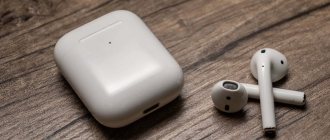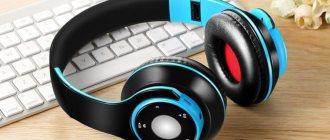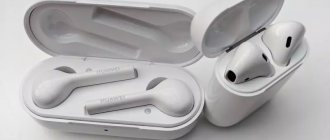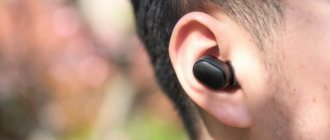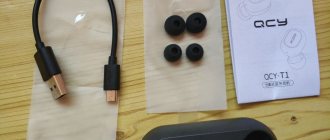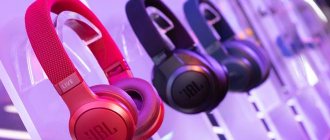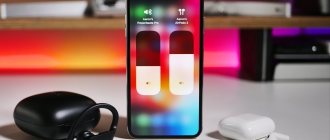What types of wireless headphones are there, and how to choose headphones for your phone with good sound? Do I need to read the characteristics of the headphones and is it possible to buy wireless in-ear headphones for my phone on Aliexpress? About this and a bunch of other things - in our mega-guide to wireless headphones.
Imagine: you spent a long time choosing and finally bought a good smartphone. With a large screen, a good battery, a smartphone that you are going to use for at least 3-4 years.
On it you will watch videos from YouTube, films or TV series on the subway on the way to work and back. Or maybe listen to audiobooks, podcasts or just music in the office or at home. Or do you simply want to have a headset so that you can be hands-free in the car or talk on the phone at minus 20, without fear that your hand will fall off from the cold or your phone will turn off in the cold?
In all these cases, you will need good ears. So you go to the store again and buy... what? Cheapest wireless headphones? The model from Xiaomi, JBL, Samsung or Huawei that has the most sales? Or will you just take the headset out of the box with your smartphone?
Let's say right away that stock headphones that come with smartphones can be safely thrown into the trash in about 90% of cases. Relatively good, but always wired headphones are equipped only with the iPhone, flagship smartphones from Samsung, Huawei, Oppo and... perhaps all of them.
Meanwhile, the difference in sound between complete headphones that cost a couple of dollars and not even good, but just normal headphones, is colossal. It is amazing and gives a real idea of what your smartphone is capable of in terms of audio reproduction.
Agree, it’s stupid to buy a cool smartphone that supports all the latest audio codecs and use headphones for 150 rubles.
But how to choose wireless headphones for your phone? Buy the most expensive ones? Not necessary.
To help you, we'll tell you everything you need to know about wireless headphones. Let's look at what types of headphones there are. We will explain all the nuances associated with wireless headphones as simply as possible, so that you do not make a mistake with your choice. And we’ll go through the most popular models of wireless headphones for phones, identifying their strengths and weaknesses.
What types of wireless headphones are there?
With all the variety of models of wireless headphones, they are easily divided into types. After reading our guide, you will never confuse one with the other.
In-ear headphones
In-ear headphones, earplugs, wireless in-ear headphones - this most popular class of headphones has several names, but, in essence, these are all types of compact headphones that are inserted into the ear.
How do wireless in-ear headphones differ from each other?
Firstly, the presence/absence of ear pads and their type.
Ear pads are made of silicone or foamed polymer materials. There are models without ear pads, such as Apple AirPods.
Headphones without ear pads have the lowest sound insulation. You can hear everything that happens around you very well. Sometimes this is useful and good - when jogging, while working out in the gym, when riding a bike, but most often it is a disadvantage. In the subway, train, or on a noisy street, such headphones are useless.
Headphones with “foam” ear pads, on the contrary, work like earplugs and perfectly cut off external noise.
The most popular models of in-ear headphones, with silicone ear pads, are somewhere in the middle in terms of sound permeability.
Ear pads for in-ear headphones can be purchased separately and exchange “silicone” for “foam” and vice versa. More expensive models of “plugs” are immediately equipped with two types of ear pads.
Secondly, in-ear wireless headphones can be divided according to the method of fixation in the ear.
They can simply be inserted into the ear, or have additional elements for a more secure fit, like sports models.
Regular in-ear headphones
In-ear headphones with “wing”
In-ear headphones with ear hook
Prev.Next
Wireless in-ear headphones may also have a body in the form of a neckband (necklace). It sometimes houses the battery and controls.
In-Ear Necklace Headphones
There are also so-called TWS headphones
TWS stands for True Wireless Stereo, if translated into Russian, then truly wireless stereo .
Why for real?
These headphones have no wires at all. They consist of two separate elements that synchronize with each other via the Bluetooth protocol.
True Wireless headphones
Thanks to Apple, this type of headphones has become the most hyped; every self-respecting company has released one or more True Wireless, of varying degrees of quality. In addition to the obvious advantage - the absence of wires - these headphones also have their own disadvantage. They get lost quite cheerfully, at least for us.
What are the good and bad things about wireless in-ear headphones?
Pros:
- Portability and mobility.
- There are moisture-resistant versions for sports and outdoor use.
- Microphones placed on the wire (with the exception of True Wireless) provide good audibility during a telephone conversation and cut off external noise. In True Wireless models, noise reduction is carried out using software algorithms with varying degrees of success.
Minuses:
- Lower, on average, sound quality than on-ear and full-size models (low frequencies are especially difficult for such headphones).
- Inability to use models with ear pads for a long time (ears get tired).
- Low quality of active noise reduction (if any).
- Short battery life.
How to choose wireless in-ear headphones?
Ideally, it is better to have several pairs for different use cases. If this is not possible, you will have to choose based on where you will use your smartphone headphones most often.
Wireless in-ear headphones are good when mobility and freedom of movement are required, and for training, sports Bluetooth headphones are, in fact, the only option.
For noisy places, such as the subway, wireless headphones with foam or silicone ear pads that provide good sound insulation are more suitable. Indoors, you can also use cushionless models. The ears get tired less in them.
Separate advice on TWS headphones. Here we strongly suggest buying the newest models. This is a new format and some older models have real problems with synchronizing the left and right earbuds. You could call these growing pains, which the latest wireless headphones have completely overcome.
On-ear wireless headphones
A larger type of headphone whose ear pads sit on top of the ears. Typically, the connecting arm of such headphones is made in the form of a headband, but there are also models of over-ear headphones with a neckband. There are few of them and they are usually intended for an active lifestyle.
Neckband headphones
On-ear headphones with good passive sound insulation are good in transport, on the street with high noise levels, and when traveling. However, they can also be used at home.
This class of wireless headphones for phones can be regarded as a transition between in-ear and full-size headphones, a compromise between compactness and sound quality. Connoisseurs of style will also like them, as such headphones look much more impressive than bulky full-size “ears”.
On-ear headphones, while not as popular as in-ear headphones, are actually the most versatile of all Bluetooth headphones. They are suitable for almost everything (there are even models for sports), except for long work.
The good and the bad of over-ear Bluetooth headphones
Pros:
- Higher sound quality than in-ear headphones of the same price category.
- longer battery life.
- compact and lighter weight compared to full-size headphones.
- Convenient carrying of folding models.
Minuses:
- impossibility of long-term use. Ear pads that are pressed tightly by the headband to the ear after some time cause discomfort (ear pads that are not pressed tightly to the ear simply do not hold well).
- Among on-ear headphones, there are few models with high-quality active noise cancellation (ANC)
- microphones in wireless models pick up too much extraneous noise. Talking on the phone with these headphones in noisy places is very difficult.
Audio Specifications
The sensitivity of headphones can be considered their volume. To avoid buying a model that is too quiet, choose headphones with a sensitivity of 95 dB or more. But always remember that excessive use of loud music can damage your hearing.
Frequency range is the range of sounds that headphones can reproduce. The human ear recognizes sounds in the range of 20 - 20,000 Hz. Choose headphones that correspond to this range, then they will produce all the sounds available to the ear.
Resistance (impedance) affects volume and overall sound quality. For most mobile devices, headphones with an impedance of 16–32 ohms are optimal. For home equipment, it is better to choose a device with a higher impedance.
Over-ear headphones
Over-ear headphones completely cover the ears and in 99.99% of cases come with a classic headband.
Closed over-ear headphones
This is a very large class of headphones, varied in price and quality. It includes headphones for travelers, professional headsets, and just headphones for lovers of good sound.
Closed full-size headphones can be used at home, on the street, in the office, and in transport. You can work in them and listen to music, watch movies and play video games, travel and communicate on the phone.
And to do all this for a long time - these are the most “humane” headphones for our ears . They provide a high level of comfort and the best sound quality. Let's make a reservation, we mean GOOD models, and not no-name trash.
The good and bad of full-size wireless headphones
pros:
- Best sound of any wireless headphone type
- Maximum wearing comfort
- Long working time
- The best passive and active noise cancellation among all classes of headphones
- Suitable for almost everything - games, music, work, watching movies, communication.
- Some models of wireless on-ear and over-ear headphones have the ability to connect them via wire. Then, if the battery runs out, you won't be left without music.
Minuses:
- Not suitable for sports
- No waterproof models
- They are large in size, which makes them inconvenient to use in winter (you have to wear such headphones over your headgear, sacrificing sound insulation). In case of rain or snow, not all models fit under the hood.
- They take up a lot of space during transportation (even folding models, even in a case).
There is another way to divide Bluetooth headphones into types - by method of use.
The first is universal wireless headphones . This includes the vast majority of wireless headphone models.
The second is wireless headphones with a microphone on a mini-boom.
This is the form factor of professional business models and gaming headsets. They provide the highest quality of your voice transmission, but at the same time, they are the most inconvenient.
The rod clings to clothes and often breaks, so such headsets are designed to be permanently located on a work or gaming desk.
And the third type is Bluetooth sports headphones. The vast majority of these headphones are in-ear, among them there are many headphones without ear pads, that is, they allow external sounds to pass through well.
However, advanced models of sports headphones with ear pads have an “ambient” mode, which allows either all or part of external sounds to pass through. And sometimes even amplifying external sounds (like a hearing aid) so that the person wearing headphones does not fall out of the surrounding reality. For example, while jogging, he could hear the barking of a dog running after him or the beep of a car.
As a rule, sports headphones have a “wing” for mounting in the ear or a bow and have increased durability and dust and moisture protection.
Key pros and cons for all earbuds
pros
- Comfort. For those who are uncomfortable with vacuum.
- Ability to hear your surroundings. Useful when walking or jogging along city streets. You won’t be hit by a car, and you won’t miss a passerby’s appeal.
- Relatively low price. It so happens that most often earbuds are cheaper than plugs.
- Sound. Usually smooth, without bloated bass. There is a relatively wide virtual stage.
- Theoretically, they are not as harmful to hearing as in-ear ones. In any case, it depends on the listening volume.
Minuses
- Noise insulation. If it's important to you, earbuds probably won't suit you. There are models that cut out ambient sound quite well, but these are not exactly earbuds.
- Landing. Headphones do not fit as firmly as in-ear headphones. Theoretically, they could fall out.
- There are almost no models with “audiophile” sound levels.
- Many may think that LF is not enough. If you are a “basshead” or just love “rock” music, it is better to look at the vacuum version.
- Not very many models. In principle, there are not enough of them, the choice is not wide.
Single word: Apple AirPods Pro
Unlike their “younger brothers”, Apple AirPods Pro play (in every sense) in a completely different league - they are in-ear plugs, not earbuds - and at least because of this they sound noticeably better than regular AirPods.
The Apple company tried to stuff its latest (at the moment) audio brainchild to the maximum:
- here is a set of external and internal microphones (for maximum effective noise reduction)
- the so-called “transparent” mode allows, on the contrary, to hear your surroundings well without removing the headphones
- Of course, Apple Siri support
- audio sharing
- more than modern H1 audio chip, responsible for minimal audio transmission delays
- ability to listen to text messages through headphones
- automatic connection to the device
- pressure equalization system
- and, as icing on the cake, fast charging: 5 minutes in the case gives 1 hour of playback.
It is a pity that all these characteristics and bright advantages are covered by the price for many.
Unusual wireless headphones
I would like to briefly mention the various exotics. For example, models of headphones with bone conduction, when sound is transmitted through the owner’s cranial bone.
Among the exotic devices, we also came across a personal mobile subwoofer that transmits low frequencies directly “to the soul.”
Several manufacturers have recently released unique sound collars with directional speakers, allowing you to watch movies or listen to music without wearing anything on your head and without disturbing others too much.
Bluetooth version is important
The built-in radio transmitter affects the sound quality. Headphones with the new version spend less energy on signal reception and reproduce voice and music more clearly.
Bluetooth is built into modern TVs, stereo systems, and players. A portable receiver is connected to old equipment. In this case, the Bluetooth version in the headphones and devices must match.
Receivers released later do not improve signal quality. Headphones with the latest version of Bluetooth receive the signal from the old version unchanged. The discrepancy is reflected in the depth of sound and bass. As a result, music sounds flat or dull in gadgets with modern software.
How to choose headphones for your phone with good sound?
Usually they write a few banal phrases here, like “listen to headphones before buying them.” I wonder how many places such advisors know where you can come and listen to in-ear headphones?
Although, if you have the opportunity to listen to headphones live, for example, by borrowing them from friends and colleagues with good “ears,” then, of course, you should listen. In stores you can usually only listen to on-ear or full-size headphones. For reasons of hygiene, they do not allow listening to in-ear ones.
If there are no friends ready to help, usually in search of wireless headphones for a phone with good sound, they are sent to the websites of manufacturers and stores, where the user immediately drowns in a lot of incomprehensible terms.
Let's try to restore order here too.
Types of emitters used in wireless headphones
Dynamic - the most popular type of emitters. Usually they say about these that they “provide a bright and expressive sound.”
Armature drivers with a balanced armature can transmit sound very accurately with minimal distortion, but do not always cope well with the low and high frequency ranges.
Some in-ear headphones have a hybrid design, when some emitters in one model are dynamic, and some are reinforced.
It is impossible to single out one or another type of sound emitter as being of higher quality . There are successful models, and there are less successful models of any design, but by far the most popular and widespread type of emitter is dynamic.
Technical characteristics of wireless headphones
Characteristics such as sensitivity, resistance (for models with wire), distortion level, frequency response matter, but... let's say SCARY: you shouldn't pay much attention to them.
Why?
On the one hand, all more or less well-known manufacturers do not make obvious technical errors that will be visible in the stated figures.
On the other hand, the characteristics specified by the manufacturer always give a very blissful picture and carry very little meaningful information. For a correct assessment, you need data from independent testing laboratories, and in order to correctly interpret such data, you need to have technical knowledge and spend more than one year in the world of sound.
And one last thing. Even perfect numbers do not guarantee that you will like the sound of the headphones.
Is there perfect sound in wireless headphones?
There is still a myth that wireless headphones sound worse than wired ones, but with the advent of audio codecs such as aptX HD and LDAC, the topic of “defectiveness” of Bluetooth headphones can be completely closed, unless you are an audiophile who is ready to spend on a player, amplifier, cables and The headphones themselves cost 300 thousand rubles or more.
Moreover, even the “old” Bluetooth codec SBC, not to mention the more advanced AAC and aptX, provides decent sound quality.
We spent many hours test-listening various models. Wired and wireless, in “with cable” modes (some wireless headphones can be connected to a sound source via cable) and without. The same musical fragments of all genres were listened to, on all streaming services available (and even inaccessible) in Russia. Hi-Res Audio tracks in FLAC format were listened to.
There was certainly a difference in sound between the different models, but it did not lie along the line between wired vs wireless headphones, but by the type of headphones and price category.
As a rule, more expensive models sounded better, more accurate and more interesting (strange), but there are nuances here too. Different brands still see the ideal sound differently and color it differently.
We can say that there are two fundamentally different approaches.
The first is an ideal frequency middle and less expressive lows and highs . This approach gives a very precise, dry and slightly boring sound. This type of sound is loved by true audiophiles.
The second is a “youth approach” with raised low and high frequencies so that everything “thumps and clucks” . These headphones sound brighter and more impressive, but less accurate.
We can say that the sound of this or that model, this or that brand lies somewhere between these two poles.
Is active noise cancellation important in wireless smartphone headphones?
Active Noise Cancelling (ANC) or Active Noise Reducing (ANR), or active noise reduction, is the most hyped audio technology used in modern wireless headphones .
It can be represented as the sum of two identical numbers, but with the opposite sign. +10 and -10 add up to zero, that is, silence. External microphones pick up external sound (+10), and the headphone speaker creates a sound wave with the same amplitude, but in antiphase to the original sound (-10). In the process of interference, sound waves are mixed into a new wave and cancel each other out (0).
Active noise reduction together with good passive noise reduction allows you to listen to music even in the hellishly noisy Moscow metro or on an airplane.
Moreover, modern ANC systems have become very sophisticated and operate on very advanced algorithms. Special proprietary applications installed on a smartphone understand how the user behaves, what he does, and accordingly adjust the operation of active noise cancellation in wireless headphones to him. So, for example, if you are a metro, then ANC works to its fullest. But if you are sitting in a chair at home or in the office, then noise reduction passes the spectrum of frequencies corresponding to the human voice, so that you can talk to you.
Almost all headphones with ANC also have an ambient mode, which we mentioned above.
Another important aspect of ANC is its ability to cancel out external noise during phone calls. Its purpose is to give your interlocutors the opportunity to hear you well, despite strong external noise.
There is only one problem with active noise cancellation. Not all companies were able to implement it effectively enough . Often the inscription ANC or ANR on the box is pure marketing. The reference solutions (for today) can be considered solutions from Sony and Bose in their series of full-size headphones WH-1000XM and QuietComfort, respectively. For other brands, the implementation of ANC ranges from “not bad” to “not at all.”
If we talk about different form factors, then so far the best active noise cancellation is implemented in full-size headphones. It’s a little worse with overhead ones, even worse with in-ear ones.
Connection methods
The method of connecting wireless earbuds to a phone on Android or iOS is standard and consists of the following steps:
- Activating the Bluetooth function on your mobile phone.
- Turn on the audio device according to the manufacturer's instructions.
- If the device synchronization procedure has already been performed, the headphones will connect automatically.
- For the initial connection, you need to find the name of the accessory on your smartphone in the list of nearby Bluetooth devices and perform synchronization.
On a note. If necessary, pairing can be established via an external Bluetooth module. This method is relevant for connecting an audio accessory to a TV that does not support wireless device pairing technology.
Wireless headphones with good call quality
The best, but unfortunately highly professional solution, is a microphone located on a mini-boom, which we discussed above.
There are wireless headphones without a boom, which effectively cut off external noise using software and hardware. This function is implemented at a higher level than others by companies with experience in producing professional headsets - Jabra, Plantronics, Bose, and very well by such a monster as Apple.
Which company to choose
You should purchase wireless headphones only from reliable manufacturers. Since such devices are not cheap and no buyer will want to overpay for a low-quality gadget.
In 2022, various types of wireless headphones can be purchased from the following brands:
- Premium segment – Apple, Samsung, Sony, Beats Studio.
- Average price category – HONOR, Huawei, Marshall Major, JBL Tune,
- Available models: Baseus, QCY, Perfeo, SVEN.
How to connect wireless headphones?
Some wireless headphones can be connected to several sound sources at the same time or, conversely, several wireless headphones can be connected to one source.
Why do you need to connect headphones to several sound sources at the same time?
You are watching a video on a monitor or TV with headphones and don’t want to miss a call. Or you have two phones, your work one and your own. You listen to music on one phone and again don’t want to miss a call on the other phone. What do you do in such a situation? That's right, connect your headphones to two sound sources at once.
Oddly enough, the implementation of, at first glance, such a simple thing as simultaneous work with several sources is normally implemented only by Plantronics and Jabra (let’s make a reservation only for the models we tested). We won’t point a finger at other vendors, even in the coolest and most expensive models, either there is no such support at all, or even with the stated support for several sources, during our listening everything worked every once in a while and quite often one of the sound sources simply fell off.
Why connect several pairs of headphones to one source?
There are significantly fewer scenarios here. In fact, only one. If you want to listen to music at the same time as someone else, but you are not satisfied with the classic “sharing ears” method. If this is what you are missing, look for this feature in JBL models.
How to charge
The wireless headset is charged according to certain rules, following which the user will be able to operate the gadget for a long time. Generally accepted recommendations:
- For charging, use the cable included with the device;
- if the original cable is lost, choose a replacement cord with the appropriate connector and current rating;
- follow the charging duration recommended by the model manufacturer;
- if the device is equipped with a level indicator, disconnect the device from the charging source when the LED shows the battery is fully charged;
- Many current models of Bluetooth accessories support the fast charging function - use the opportunity to recharge the device for 2-3 hours of work in 10 minutes.
Controlling wireless headphones
The old-school style of controlling headphones—three buttons on a wire—is gradually becoming a thing of the past. Control becomes more intelligent and ergonomic.
In wireless headphones, it is usually located on the ear cups, if these are on-ear and full-size models, on the cable or plastic in in-ear headphones, or on the in-ear speakers themselves, if these are True Bluetooth headphones.
Wireless headphones have both mechanical and touch controls . Touch gesture control, on the one hand, is more convenient, on the other hand, it is more capricious, especially at low temperatures. There is also a risk of accidental operation.
Mechanical solutions, however, can also be very sophisticated. Controlling the Plantroincs headphones with ring controls and a gyroscope is an example of ingenious engineering and excellent ergonomics.
However, not only Plantroincs, but also some other companies have mastered the gyroscope and automatic pause when removing headphones.
Soundproofing
Loud outside noise can ruin your favorite songs or interfere with an important phone conversation. To protect yourself from it, take a closer look at models with increased sound insulation.
Internal earbuds, also known as vacuum headphones, and external closed-back headphones are best at blocking out ambient sounds.
Some models protect against noise not only due to design features, but also with the help of special functions. So, there are headphones with active noise reduction technology. They monitor surrounding sounds through a microphone and automatically block out noise when needed. But this technology consumes battery power and increases the cost of headphones.
Sony MDR100ABNB Active Noise Canceling Headphones
What specific models of wireless headphones for smartphones can we recommend?
Let us warn you right away: there are a lot of good headphones. Fewer than bad ones, but still a lot .
We can only give recommendations on those models that we have listened to ourselves. Moreover, due to the vastness of the topic, there will only be popular and affordable brands and models.
In-ear wireless headphones
BeatsX is not new, but it's a good wireless model for the iPhone. Good sound and perfect compatibility with Apple devices are guaranteed.
Sony WI-1000XM is a series already consisting of two generations with active noise reduction, good sound, and the ability to connect via wire to a sound source. This is rare for in-ear headphones.
Jabra 65t series (Elite, Elite Active, Elite Sport, Evolve) are TWS headphones. A very successful line of “true” wireless headphones, including sports and “business” versions. Good passive sound insulation, external microphones with noise reduction. Ambient mode, good sound, including low frequencies, support for two sound sources, convenient control.
Apple AirPods 2 is a legendary model that is ideal for iPhone. Excellent ergonomics, good sound. There is one minus - there is no noise reduction, either active or passive. And of course we are all waiting for Apple AirPods 3.
BOSE SOUNDSPORT IN-EAR HEADPHONES are great sports headphones. Good sound quality and powerful passive sound insulation or... lack of it when choosing the appropriate type of ear pads, rich equipment.
Xiaomi Air 2 and Redmi AirDots are completely wireless headphones from Xiaomi, which are simply destined to be hits at prices of 50 and 15 dollars. Such price offers from a category A brand simply do not exist in nature.
Huawei FreeBuds 3 are the first fully wireless headphones with Bluetooth 5.1 support. There is active noise cancellation. Very advanced model with good sound.
Adidas Sport model FWD-01 - new and spectacular sports headphones from Adidas. Battery life reaches 16 hours.
Under Armor True Wireless Flash by JBL are another sports headphones and also a collaboration between the manufacturer of clothing and headphones, only a completely wireless model. Very comfortable, excellent passive noise reduction + ambient mode, peppy sound. Everything is as it should be with JBL.
On-ear wireless headphones
Marshall Major III Bluetooth - 30 hours of battery life, spectacular design, good sound and insane popularity among fans of the brand.
Bowers & Wilkins PX5 Wireless are very comfortable headphones for music lovers with excellent sound, luxurious design, cool passive and good active noise reduction. There is only one minus. VERY EXPENSIVE.
The AKG N60NC Wireless don't have as great a sound as the previous model, but they still sound very decent, and passive and active noise cancellation allows you to listen to sound almost anywhere. There is the possibility of connecting via wire and 30 hours of battery life
Autonomy, Bluetooth and ANC
The operating time without recharging determines:
- Capacity of built-in batteries.
- Battery installed in a case.
- Bluetooth version.
- Music volume.
- The presence of active noise reduction.
Compact models last 4-8 hours on a single charge. The included case, which acts as a portable charger for the headphones, extends their operating time to 12-36 hours. Sports solutions connected by cable operate for around 12 hours and have a battery built into the design.
Full-size ones can last up to 100 hours without recharging. Similar to smartphones, headphones began to receive a fast charging function: after being powered from the case/cable for 10-15 minutes, the resulting energy is enough for 1-2 hours of playing music.
The characteristics of wireless headphones indicate the average battery life at 50% volume. Increasing the sound level and listening to tracks with active bass reduces the specified time and vice versa.

